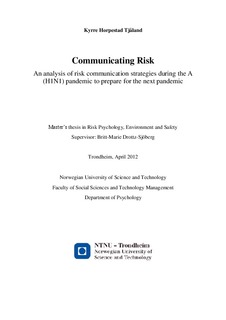| dc.contributor.advisor | Sjöberg, Britt-Marie Drottz | nb_NO |
| dc.contributor.author | Tjåland, Kyrre Horpestad | nb_NO |
| dc.date.accessioned | 2014-12-19T14:42:24Z | |
| dc.date.available | 2014-12-19T14:42:24Z | |
| dc.date.created | 2012-06-19 | nb_NO |
| dc.date.issued | 2012 | nb_NO |
| dc.identifier | 535343 | nb_NO |
| dc.identifier.uri | http://hdl.handle.net/11250/270830 | |
| dc.description.abstract | This thesis addresses the topic of risk communication effectiveness on a national level in Norway regarding a future pandemic. The consequences of a pandemic influenza will depend partly upon the risk communication strategy effectiveness. Within risk psychology research, such a strategy should fully consider how general and situational factors may influence public perceptions of the pandemic risk, and how public perceptions affect risk communication efficiency and, consequently, the behavior of recipients towards the pandemic. If ignored, communication gaps could result in overall greater consequences for the general public and/or unequal protection for vulnerable risk groups during a future pandemic.
The overall aim of the thesis is therefore to help enhance risk communication efficiency, and thereby risk management. To address this area of research the thesis summarizes scientific research on risk perception and risk communication, and reviews experiences from prior situations and cases. The central interest of the thesis has been how public perceptions of a pandemic risk relate to risk communication efficiency and communication strategy. Scientific communication models used to address public perceptions, which may limit or hinder correct health behavior, are presented and their use in potential future pandemic settings are discussed. The thesis argues that risk communication efficiency will be strengthened by use of scientific models of communication. In this context especially models on information processing (i.e. ELM), approaches eliciting mental contents (i.e. mental models), and practical work with communication of risk (i.e. RISCOM).
Predictions of future pandemics are extremely hard to make. To cover various possibilities within a future pandemic this thesis discusses risk communication challenges in situations with different combinations of possibility and consequences (severity of the virus). The idea is that different situations demand different amount of, and different approaches to, the management of risk. Lastly, an effective risk communication strategy does not stop when the pandemic risk officially subsides. It is recommended that communicators learn from the "rights and wrongs" encountered in the latest pandemic and thus ensure public trust in risk communication for the next health risk. | nb_NO |
| dc.language | eng | nb_NO |
| dc.publisher | Norges teknisk-naturvitenskapelige universitet, Fakultet for samfunnsvitenskap og teknologiledelse, Psykologisk institutt | nb_NO |
| dc.subject | Social and Behavioural Science, Law | en_GB |
| dc.title | Communicating Risk: An analysis of risk communication stategies during the A (H1N1) pandemic to prepare for the next pandemic | nb_NO |
| dc.type | Master thesis | nb_NO |
| dc.source.pagenumber | 115 | nb_NO |
| dc.contributor.department | Norges teknisk-naturvitenskapelige universitet, Fakultet for samfunnsvitenskap og teknologiledelse, Psykologisk institutt | nb_NO |
